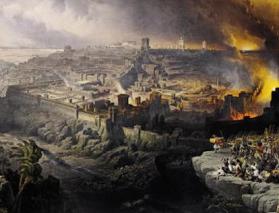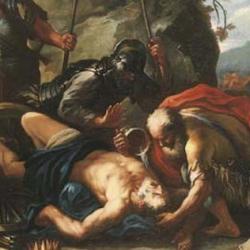After nine long chapters of names, genealogies, and snippets of narrative, the Chronicler plunges the reader into a scene of frantic action: Saul’s battle with the Philistines on Mount Gilboa (1 Chronicles 10; cf. 1 Samuel 31). The story of Israel’s monarchy starts out as a sad story of the death of kings.
Why start here? Summarizing the work of Rudolph Mosis, Saul Zalewski argues that Saul foreshadows the various kings who do evil in the eyes of Yahweh. Like other commentators, Mosis emphasizes the importance of “transgression” (Heb. ma’al) and points to specific cases where the concept plays a key role in the fate of kings: “the story of the death of Saul (1 Chr. x 13), the description of the evil deeds of Ahaz (2 Chr. xxviii 19), and the description of the destruction of Jerusalem (2 Chr. xxxvi 14).”
Zalewski notes that “Mosis finds a special resemblance between Saul and Ahaz. Whereas Hezekiah is conceived of as a second David, Ahaz his father is conceived of as a second Saul. The disasters which came down upon the state in the time of Ahaz are narrated in 2 Chr. xxviii. The king of Aram (v. 5) and the Edomites (v. 17) had taken captives from Judah while the Philistines had invaded the cities of Judah, had taken many cities, and had settled in them (v. 18). This description of the deeds of the Philistines in the time of Ahaz reminds us especially of the situation described in the story of the death of Saul (1 Chr. x 7)” (451). Ultimately, Saul’s death foreshadows “the sins of Israel and its kings caused the destruction of the Land and the exile of the people to Babylon” (451).
Zalewski doesn’t buy it. Ahaz’s sin isn’t to imitate Saul but to follow the ways of the kings of Israel. More generally, Saul’s name is never mentioned after 1 Chronicles 26:28. He concludes that “Saul does not serve as a negative example for the sinful kings who came after him” (452). This is weak. It isn’t necessary for Saul and Ahaz to be the same in every respect for the two kings to form an internal typology. The parallel between Saul-David and Ahaz-Hezekiah is strong, and has significance for the theology of Chronicles as a whole.
Mosis also finds a contrast between Saul and Josiah with regard to the “word of the Lord.” Saul’s failure to guard the Lord’s word is one dimension of his ma’al, and Josiah’s righteousness is evident in his insistence on following the word of Yahweh (2 Chronicles 34:21). These are the only two places where the phrase “the word of Yahweh” appears in Chronicles. Josiah is the last to do so, and Judah goes into exile because she rejects and mocks the prophets, the Lord’s messengers (453). The collapse of Saul’s house because of his transgression again foreshadows the complete collapse of exile.
Zalewski is right to say—against Mosis—that the specific sins of 1 Samuel are relevant to the Chronicler’s account. But that doesn’t cancel out the various internal echoes of Saul in the book.
(Zalewski, “The Purpose of the Story of the Death of Saul in 1 Chronicles X,” Vetus Testamentum 39:4 [1989]: 449-467.)














